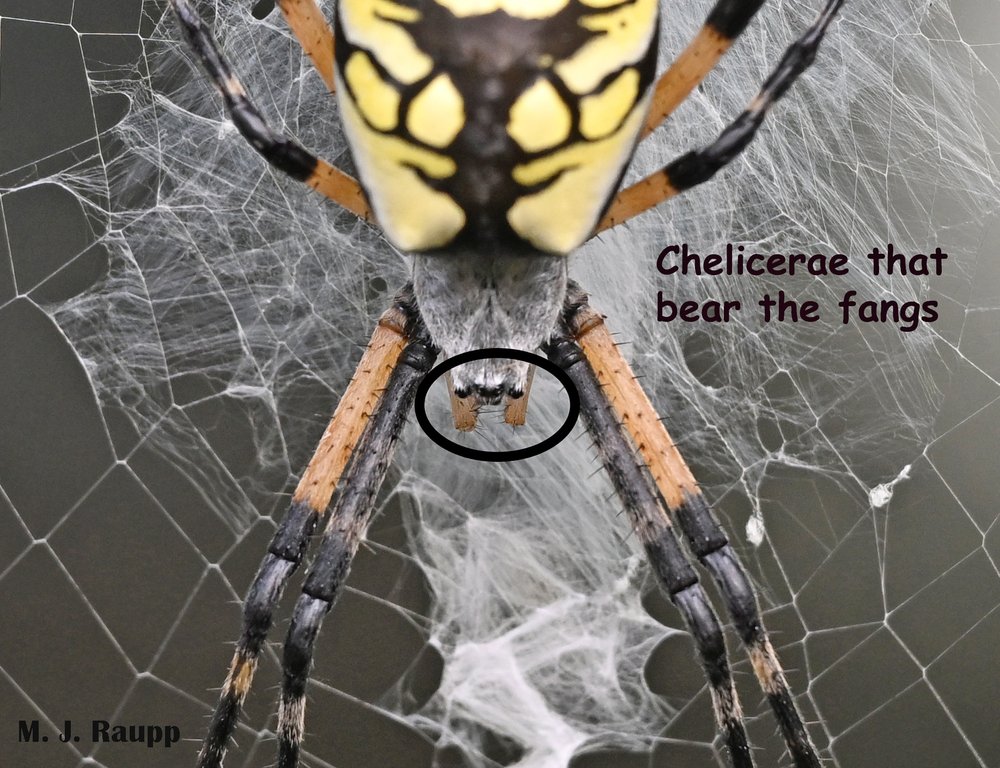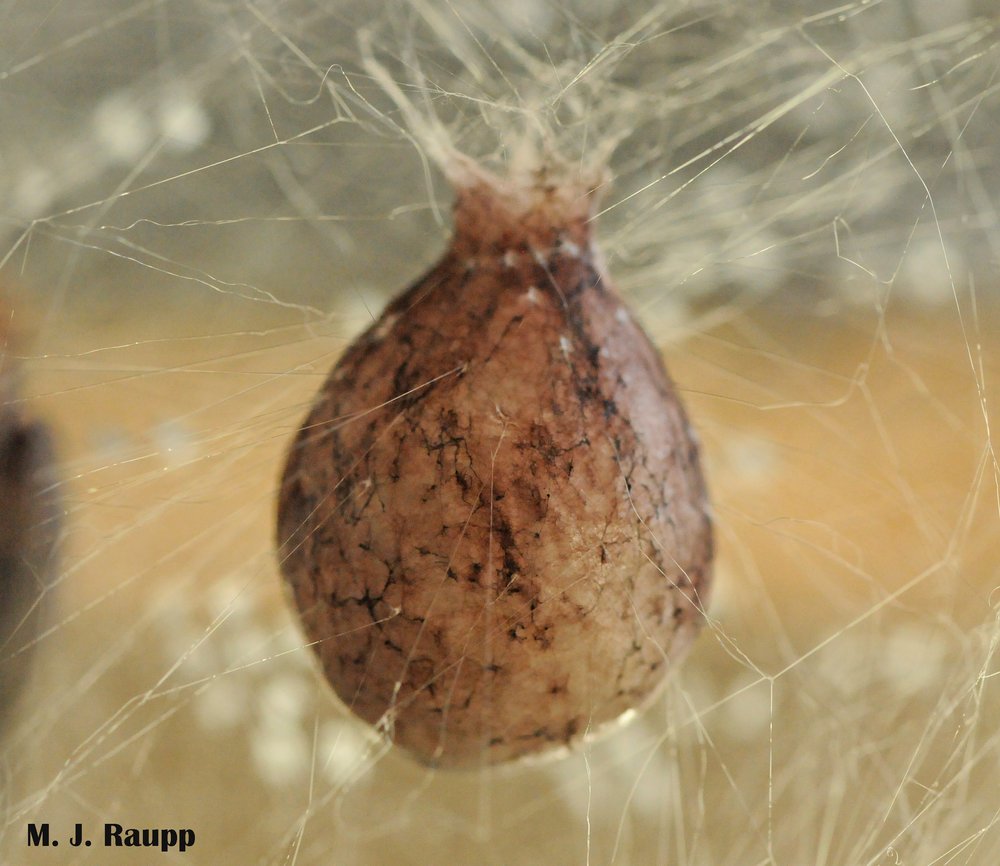Got lanternflies? Tired of squishing? Get a spider! Black and Yellow Garden Spider, Argiope aurantia

My lovely black and yellow garden spider spends most of her day resting on the stabilimentum at the center of her enormous web.
In a recent episode, we lamented frustrating efforts to halt the spread of spotted lanternfly in the early years of its arrival in the US. We also know that vertically challenged humans can only reach and destroy by scraping an unsatisfyingly small proportion, about 2%, of lanternfly eggs deposited on trees. We know that several predators (birds, mammals, amphibians, and fish), parasitoids, and pathogens, all part of Mother Nature’s Hit Squad, are helping to put a beat-down on lanternflies. This week we add one more predator to a growing list of good guys helping to squelch the lanternfly invasion, the black and yellow garden spider.

Just in front of the spider’s eyes are two brown chelicerae which bear fangs used to administer venom and macerate the prey.
Sometimes good fortune smiles on my garden, and last week a drop-dead gorgeous black and yellow orb weaver decided to set up shop just outside of my picture window beneath an overhanging eve. You may have shared my experience of wandering along a path through a meadow and bumbling into an enormous spider web ruled by a fearsome black and yellow spider. Argiope aurantia, the so-called black and yellow garden spider, belongs to family known as Araneidae, the orb weavers, made famous by E. B. White in his classic tale ‘Charlotte’s Web’. Webs of the black and yellow garden spider can be gargantuan, often spanning several feet. You may recall that Charlotte used her web to write eloquent praises for her friend Wilbur in an attempt to rescue him from becoming a porcine feast for farmer John. To my disappointment, my giant spider has only somewhat mastered the letter “W”, (or is it “M?”) which she copies repeatedly to create a conspicuously large band of zigzagging “W’s” in the center of her web.
An ill-fated spotted lanternfly struggles to free itself from sticky strands of the spider’s web. Web vibrations alert the spider to the victim’s presence. Lightning fast, the spider dashes from the center of the web and immobilizes the lanternfly with sheets of silk. With its prey swaddled and helpless, the spider delivers lethal bites to the lanternfly. She then retreats to the center of her web. As daylight wanes, the spider moves its meal to the center of the web. Using powerful fangs, she macerates the lanternfly and then slurps liquefied lanternfly into her digestive tract. By nightfall, the lanternfly is but a shriveled hulk. Bye, bye, lanternfly.
Spider aficionados call this band of heavy silk the stabilimentum. The function of the stabilimentum is a topic of debate among arachnologists. Some suggest that the band helps disguise the spider from its predators by providing a form of camouflage as the spider rests in the center of its web. Others believe that the silk may act as a tiny parasol shielding the spider from intense rays of the sun. One fascinating study revealed that the conspicuous bands of silk acted as a visual warning to low flying birds, thereby reducing the likelihood of devastating web-destroying crashes much the same way an image of an owl on a large plate glass window dissuades misguided birds from crashing and breaking their necks. Of course, the spider cares not for the welfare of the bird, but repairing bird-damaged webs takes time away from important projects like capturing and eating insects.
Other encounters with black and yellow garden spiders, like gently poking them, provoke a remarkable behavioral display called web-flexing. Here the garden spider retreats slightly from the stabilimentum and begins to rhythmically flex and extend its legs. These gyrations set the entire web rocking back and forth in ever-increasing waves. Swaying the web in rhythmic motion is often observed in orb weavers. Web-flexing has been reported as a way of dislodging potential predators or causing prey to become entangled in sticky capture-threads in the web.
On a rainy morning, Sylvia, a black and yellow garden spider, uses her forelegs to rock her web back and forth. This behavior known as web-flexing may help her snare prey, dodge predators, or, perhaps, shed raindrops that accumulate on capture-threads of her web. Another black and yellow garden spider has had a very successful season producing two marble-sized egg cases from her harvest of prey. Video credits: Michael Raupp and Ann Payne
Flexing may serve other defensive purposes as well. Enemies of the orb weaver include predatory lizards, toads, and other spiders that rely on keen eyesight to locate and capture prey. In an interesting treatise on orb weavers, researcher Wayne Tolbert suggested that web-flexing might be a clever way for the spider to conceal its exact location, thereby confounding hungry predators.

The egg sac of the black and yellow garden spider contains hundreds of eggs and is the size of a large marble.
As fate would have it, swarms of spotted lanternflies reside in our research plots near Antietam Battlefield. They provide a ready source of food for my pet spider. Lanternflies stand no chance once they encounter the sticky strands of the web. The speed with which my spider immobilizes her victim in a silken wrapper is reminiscent of Frodo’s wicked encounter with Shelob en route to Mount Doom. Sometimes the prey is treated to a bite or two from the spider’s impressive fangs. On other occasions, she simply wraps up the victim and later fetches it to the center of the web where the snack is devoured. Over the next several weeks, my orb weaver will play a small role in helping to reduce populations of spotted lanternflies. I hope she will soon deliver a large marble-sized egg case somewhere in her lair. These eggs will be repatriated with the spotted lanternfly outbreak in Washington County where they will join their feral kin in the battle to quash these beautiful but noisome lanternfly invaders.
Acknowledgements
We thank Virginia Master Gardeners of Greenspring Gardens for providing the inspiration for this episode. Three great articles, “Predator avoidance behaviors and web defense structures in the orb weavers Argiope aurantia and Argiope trifasciata” by W. Tolbert, “Do stabilimenta in orb webs attract prey or defend spiders?” by T.A. Blackledge and J.W. Wenzel, and “Using community science to identify predators of spotted lanternfly, Lycorma delicatula (Hemiptera: Fulgoridae), in North America” by A.E. Johnson, A. Cornell, S. Hermann, F. Zhu and K. Hoover were consulted for this episode of Bug of the Week. To learn more about all things spotted lanternfly, please visit Penn State’s awesome spotted lanternfly website at this link: https://extension.psu.edu/spotted-lanternfly
This post appeared first on Bug of the Week